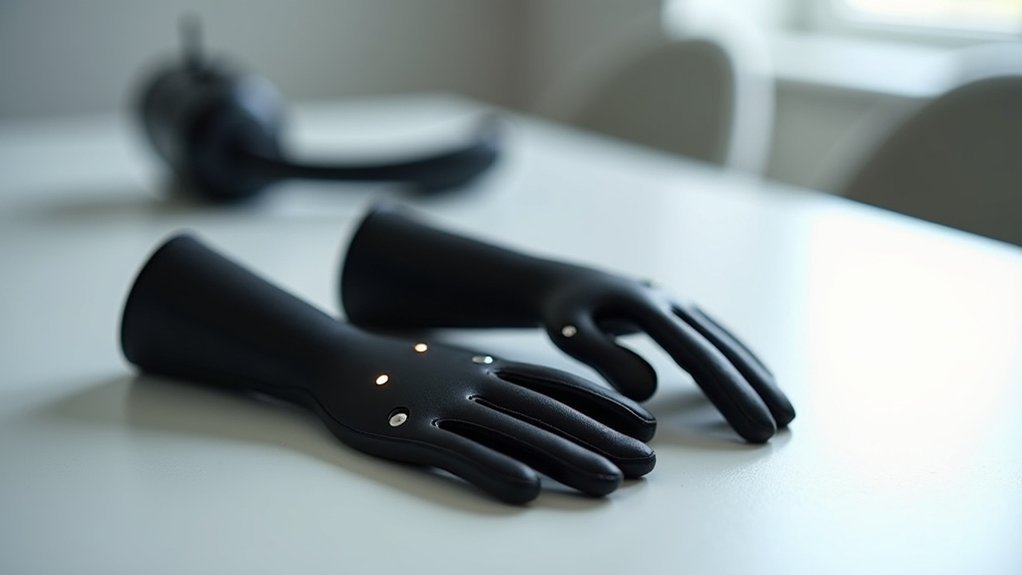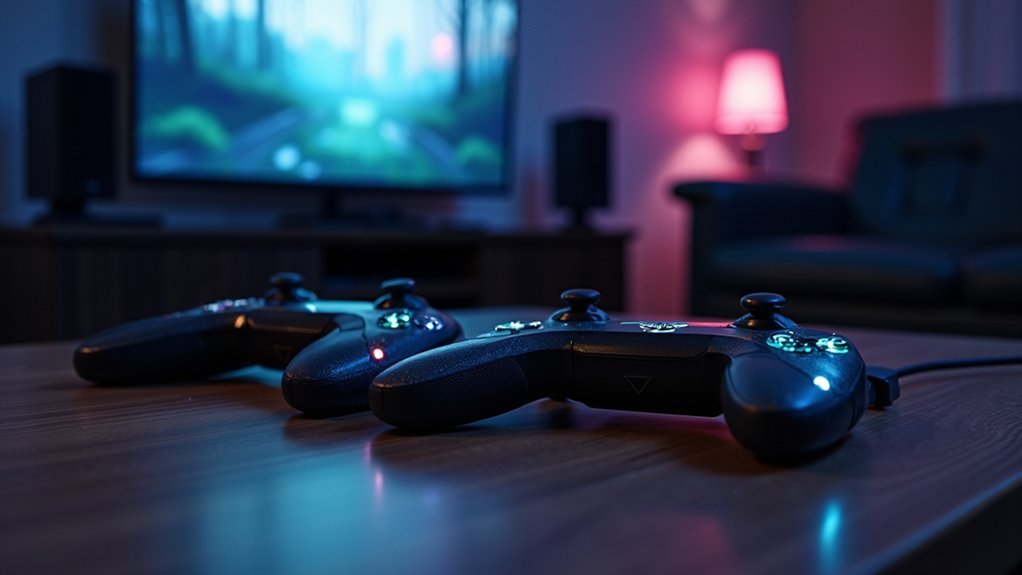You’ll experience submillimeter precision with haptic gloves that replace clunky button controls through natural hand gestures and realistic touch sensations. While they cost $200-$300 compared to traditional controllers at $100-$200, you’re getting advanced tactile feedback that simulates textures, weight, and resistance of virtual objects. You’ll need several hours to develop new muscle memory, but the immersive experience surpasses basic vibration patterns. Discover how compatibility challenges and battery considerations might influence your VR setup decisions.
Precision and Accuracy in Virtual Touch Sensations

While traditional VR controllers rely on button presses and basic motion tracking, haptic gloves revolutionize virtual interactions through submillimeter finger tracking precision that captures every subtle movement of your hands.
You’ll experience virtual touch sensations that mirror real-world interactions with unprecedented accuracy. The Bifrost Pulse VR Gloves demonstrate this technology’s potential, delivering haptic feedback that simulates the authentic feeling of grasping objects, texturing surfaces, and manipulating materials in virtual environments.
This precision transforms how you interact with digital worlds. Instead of approximating actions through button combinations, you’ll naturally reach, grab, and manipulate virtual objects using intuitive hand gestures.
This precision eliminates clunky button controls, letting you naturally grasp and manipulate virtual objects through intuitive hand movements.
The tactile responses create convincing illusions of weight, texture, and resistance, making virtual experiences feel tangible and believable.
Cost Analysis of Haptic Gloves Versus Traditional Controllers
When you’re considering the financial investment, haptic gloves like the Bifrost Pulse VR Gloves command prices between $200-$300, representing a significant premium over traditional VR controllers that typically cost $100-$200.
However, you’re getting substantially more value for your money. While traditional controllers offer basic motion tracking and button inputs, haptic gloves deliver submillimeter finger tracking and tactile feedback that transforms your VR experience.
The higher manufacturing costs reflect the advanced technology required for precise finger tracking and haptic feedback. If you’re a serious gamer or developer pushing VR boundaries, this investment pays off through enhanced realism and engagement.
As haptic gloves gain market traction, you’ll likely see consumer preferences shifting toward these premium devices despite their steeper price point.
Learning Curve and User Adaptation Requirements

Although the investment in haptic technology offers tremendous potential, you’ll encounter a noticeable learning curve that requires patience and practice.
Haptic gloves demand developing new muscle memory and coordination skills that differ greatly from traditional controllers. You’ll need several hours to achieve proficiency with finger tracking and nuanced feedback systems.
Initially, you might experience frustration with sensitivity levels, requiring adjustments to grip pressure and movement speed for ideal VR interaction.
However, guided tutorials and specially designed gameplay mechanics can ease this changeover by gradually introducing you to haptic capabilities.
With continuous use, you’ll notice improved comfort and confidence.
As familiarity grows, haptic gloves transform from challenging accessories into intuitive tools that deliver the immersive, enjoyable VR experience they promise.
Battery Life and Hardware Durability Considerations
You’ll need to take into account how haptic gloves handle power consumption during marathon VR sessions, as most models like the Bifrost Pulse VR Gloves offer 4-8 hours of battery life depending on your usage intensity.
Your gloves must withstand constant finger movements and potential impacts, so you’ll want reinforced stitching and tear-resistant materials that won’t fail after months of intensive use.
You can extend both battery performance and hardware longevity through proper charging practices and regular maintenance, but you should also look for modular designs that let you replace worn components rather than buying entirely new gloves.
Extended Session Power Management
Since extended VR sessions can last several hours, effective power management becomes essential for maintaining consistent haptic feedback throughout your gameplay.
You’ll find that modern devices like the Bifrost Pulse VR Gloves incorporate energy-efficient components that balance performance with longevity. Smart sleep modes automatically activate when you’re not actively using the controllers, preserving battery life without interrupting your immersive VR experience.
Extended session power management features you’ll encounter include:
- Adaptive power scaling that reduces energy consumption during low-intensity haptic moments while maintaining full feedback for vital interactions
- Intelligent hibernation modes that detect when your hands are at rest and temporarily power down non-essential systems
- Real-time battery optimization through software updates that learn your usage patterns and adjust power distribution accordingly
Physical Component Wear Resistance
Battery optimization strategies work hand-in-hand with the physical durability of your haptic gloves, as repeated charging cycles and intensive use patterns directly impact both power retention and component longevity.
You’ll find that durable materials in haptic gloves withstand regular wear and tear while maintaining functionality. The integration of robust connectors and reinforced seams enhances resistance to physical stress, ensuring your hardware survives demanding gaming sessions.
Advanced haptic feedback systems incorporate low-power components that balance performance with battery longevity. When you’re aiming for 4-6 hours of continuous use, efficient power management becomes essential.
Regular software updates optimize both battery performance and durability by reducing power consumption and enhancing hardware longevity, giving you the reliability needed for extended immersive experiences.
Game Compatibility and Software Integration Challenges

You’ll encounter significant hurdles when trying to use haptic gloves with existing VR games that weren’t built for hand tracking technology.
Most legacy titles rely on traditional controller inputs, creating complex mapping issues that can’t translate your natural hand movements into proper game commands.
Developers face substantial barriers when considering haptic glove support, often requiring complete redesigns of their input systems and additional resources they may not have available.
Legacy Game Integration
While haptic gloves and face controllers offer cutting-edge immersion, integrating them with legacy VR games creates significant compatibility hurdles that you’ll need to navigate.
Most older VR titles weren’t designed with haptic feedback in mind, making it challenging to add touch sensations without major software overhauls. You’ll often encounter reverse engineering requirements or need specialized middleware to connect traditional input systems with advanced haptic gloves capabilities.
The integration process demands careful attention to user experience. You must guarantee haptic feedback enhances gameplay rather than overwhelming players with confusing sensations.
- Feeling virtual raindrops cascade across your fingertips in a fantasy adventure
- Gripping a sword handle with realistic resistance during combat sequences
- Sensing texture variations while exploring ancient stone corridors
Manufacturer support through regular updates remains essential for successful implementation.
Controller Mapping Issues
When you attempt to use haptic gloves with existing VR games, controller mapping issues immediately surface as the primary technical barrier. Most VR games are built exclusively for traditional controllers, creating compatibility challenges that prevent you from accessing intended gameplay features.
You’ll encounter software integration difficulties requiring precise finger tracking and feedback systems that aren’t universally supported across platforms. The absence of standardized protocols means you’ll face inconsistent experiences when switching between games or applications.
Without custom software modifications or additional mapping tools, haptic gloves often can’t function properly. Developers must create specific updates or plugins for peak performance, but this requirement slows adoption rates considerably.
You’re fundamentally caught between cutting-edge hardware and software that hasn’t evolved to support it.
Developer Adoption Barriers
These compatibility problems create a domino effect that discourages developers from embracing haptic glove technology in their projects.
You’ll find that retrofitting existing VR games requires substantial modifications to support finger tracking and haptic feedback features. The software integration landscape becomes particularly challenging when you’re forced to navigate diverse SDKs and APIs from different manufacturers.
The absence of standardized protocols creates inconsistent user experiences across platforms, making you hesitant to invest development time. High costs associated with creating and testing haptic-enabled experiences often push smaller indie developers away from adopting haptic gloves entirely.
- Wrestling with tangled code while trying to merge incompatible haptic APIs
- Watching frame rates plummet as additional processing demands overwhelm your system
- Burning through budget allocations for endless compatibility testing cycles
Immersion Level and Realistic Feedback Comparison
Although traditional face controllers have dominated VR interaction for years, haptic gloves now deliver an unprecedented level of immersion through advanced tactile feedback systems.
When you wear gloves like the Bifrost Pulse, you’ll experience submillimeter finger tracking that captures every subtle movement. The haptic feedback lets you feel textures, resistance, and weight of virtual objects—something face controllers can’t replicate with their basic vibration patterns.
You’ll notice the difference immediately when grabbing virtual items. Haptic gloves simulate realistic sensations as you manipulate objects, while face controllers limit you to button presses.
The natural range of motion transforms your VR experience, allowing intuitive gestures like throwing and catching. This realistic feedback creates deeper engagement than conventional controllers, marking a significant leap forward in immersive technology.
Frequently Asked Questions
Do Haptic Gloves Work?
Haptic gloves do work, but you’ll find their effectiveness varies considerably. High-quality models provide accurate finger tracking and realistic touch feedback, while cheaper versions offer limited functionality. You should research specific brands before purchasing.
Is Udcap Real?
You’re looking at a legitimate haptic feedback project that’s currently in development. Udcap’s creating VR controllers and gloves with tactile sensations, though there’s no confirmed release date or pricing yet available.
Do Haptic Gloves Work With Oculus Quest 2?
You can use haptic gloves with your Oculus Quest 2 through third-party options like Bifrost Pulse VR Gloves. They’ll provide enhanced finger tracking and feedback, though compatibility varies by software.
How Much Do Haptic Gloves Cost?
You’ll find haptic gloves ranging from $200-300 for affordable options like Bifrost Pulse, while premium models exceed $1,000. Crowdfunding projects offer competitive pricing, and costs are decreasing as VR technology advances.
In Summary
You’ll find haptic gloves offer unmatched precision and immersion that traditional controllers can’t match, but you’re paying premium prices for cutting-edge technology. You’ll need time to adapt to the learning curve, and you’ll face battery limitations plus compatibility issues with many games. If you’re seeking the most realistic virtual touch experience and don’t mind the investment, haptic gloves deliver. Otherwise, you’ll get reliable performance sticking with traditional controllers.





Leave a Reply